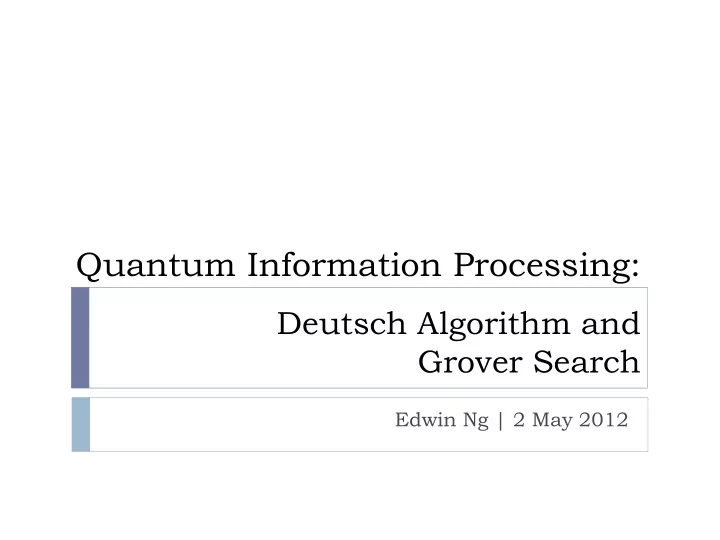

Quantum Information Processing: Deutsch Algorithm and Grover Search Edwin Ng | 2 May 2012
The Computational Basis The computational basis states of the molecule are These correspond to the classical bits NMR quantum computation manipulates superpositions of these basis states to solve problems faster than classical algorithms
The Computational Basis: FIDs
The Computational Basis: FIDs
Basis Probabilities If the state is measured in the computational basis, what is the probability of each state? After normalization, the proton and carbon FIDs gives V 1 H , V 2 H , V 1 C , V 2 C They represent the following system:
Basis Probabilities (Cont.) ρ jj represents probability of measuring the j- th basis element We do not need the imaginary elements System is rank-deficient: add normalization
Basis Probabilities (Cont.)
Simple Quantum Gates: One-Qubit NMR is based on single-qubit rotation gates: These rotate the spin by π /2 about x , y axis of the NMR system ( π /2 pulses). X 2 and Y 2 are π pulses; we also have - π /2
Simple Quantum Gates: Two-Qubits In two-qubit NMR, the two nuclei couple together through J-coupling constant This yields spin-spin interaction operator Achieved by letting system freely evolve for time τ = 1/2 J
The Controlled-NOT (CNOT) Gate Defined by Classical Truth Table: The first bit is the control, the second bit is the target. CNOT flips target iff control is 1.
The CNOT Gate: Circuit Quantum CNOT is a two qubit-circuit There is also a much simpler near-CNOT gate, disregarding phases
The CNOT Gate: FIDs
The CNOT Gate: FIDs
The CNOT Gate: Probabilities
The Deutsch Algorithm: Question Given a function Constant f 0 and f 3 vs. Balanced f 1 and f 2
The Deutsch Algorithm: Setup Classical approach : Ask for both f (0) and f (1) Quantum approach : Ask for only one thing, but need to choose that one thing carefully D is a unitary operator: i.e. , a quantum gate Goal is to query D at most one time, which would beat classical case
The Deutsch Algorithm: Setup (Cont.) For each f j , there is a D j oracle
The Deutsch Algorithm: Solution The following quantum circuit solves the Deutsch problem in one query of D : Measuring gives 00 if constant, 10 if balanced
The Deutsch Algorithm: FIDs
The Deutsch Algorithm: FIDs
The Deutsch Algorithm: Probabilities
The Grover Algorithm: Question Given a set X of N items and Exactly one element x 0 is marked 1 Goal : Find x 0 Classical approach is to just search all of X This takes time Quantum approach indexes X using states Ultimately takes time
The Grover Algorithm: Setup Instead of querying g, ask for an oracle instead O is a unitary operator on basis bitstrings x : Marks the answer using a “phase kickback” How to phrase the oracle query?
The Grover Algorithm: Setup (Cont.) A single query consists of the Grover iterate P is a conditional phase H is the Hadamard operator
The Grover Algorithm: Solution Goal: Use as few Grover iterates as possible Measuring at the end of iterations gives x 0 with high probability Will also get x 0 after k + k 0 , k+ 2 k 0 , … iterations
The Grover Algorithm: Implementation Ignoring global phases and simplifying, we get a pulse sequence for each Grover iterate The Hadamard is
The Grover Algorithm: FIDs
The Grover Algorithm: FIDs
The Grover Algorithm: Probabilities
Conclusions Introduced a way to calculate the probabilities of each basis element after a computation Demonstrated the preparation of basis states Obtained a CNOT gate with correct classical outputs Verified the correctness of the Deutsch algorithm Observed the correctness and oscillatory behavior of the Grover search algorithm Also available: Classical truth table for near-CNOT gate Near-CNOT, CNOT, Deutsch using carbon control
Question and Answer
Recommend
More recommend